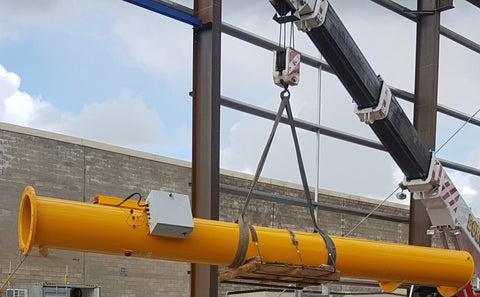
Lifting Slings and Load Slinging
In this blog, we look at the three broad categories of lifting sling, examine their key features, and explore how each might be used below-the-hook of a hoist or crane.
Slings are among the most widely used lifting accessories. They fall into three main categories:
- Textile
- Chain
- Wire rope
The sling you choose will depend on a number of considerations, including the load, pick points, lifting technology, environment, application, and more.
In all cases, it’s important that they are only used by competent professionals that understand the equipment and its intended purpose.
Let’s look at each type of sling:
Textile
When people talk about textile slings, they might be referring to those made from webbing and fiber rope—and endless roundslings.
Natural fiber rope is actually the oldest lifting medium. It remains available, but polyamide, polyester and polypropylene are now more common on the market. Strength varies according to the type of fiber used. You might have heard references to hemp and sisal, which are of similar strength at the lower end of the scale; then there are manila, polypropylene, polyester and polyamide (nylon).
- Did you know that nylon is two-and-a-half times as strong as Grade 1 manila of the same diameter?
- Another interesting fact is that polypropylene rope will float in water.
Always remember that natural fibers are susceptible in damp conditions and are not suitable for most chemical environments. Manmade fibers, meanwhile, are immune from rotting but have varying resistance to chemicals—and all fiber ropes are prone to deterioration at high temperatures.

Polyester eye and eye slings can be used in choker, vertical and basket hitches. Sling eyes will be wrapped at the bearing point unless otherwise specified.
Manmade fibers rarely show a sharp melting point; they will either soften over a range of temperatures or decompose before melting. Generally, we say that textile slings should not be used above approx. 176°F or below 32°F but always ask the manufacturer and / or supplier.
Fiber rope
Fiber rope slings are soft compared to chain and wire rope and are therefore less likely to damage the surface of a load. However, they can easily be cut if loaded over a sharp edge without adequate packing (protection). The length of a fiber rope sling cannot be adjusted.
Webbing slings are manufactured in a similar variety of materials as manmade fiber ropes, although the most popular are those made from polyester. They are light in weight and can be made in various widths, which is an advantage when lifting loads that are vulnerable to damage from a narrow point of contact.
But do not load across a corner at an angle, as would be the case if a pair of slings are used to cradle a load in basket hitch. This causes the load to be imposed on the outer edge of the webbing rather than uniformly across it.
Webbing can be used to make multi-leg slings but the most popular and versatile are single leg slings. The eye terminations are made by turning the webbing back and stitching. Except for the narrow webbing, the width at the crown of the eye is reduced by folding the material in one of several patterns. The crown is also reinforced to protect it against wear.
Reducing the width of the eye in this way facilitates connection to other components such as shackles or hooks.

The sling you choose will depend on a number of considerations.
Roundslings
Roundslings are an endless sling comprising a load-bearing core of high-tenacity continuous-multifilament yarn that is completely enclosed in a woven cover, with or without end fittings.
Roundslings are an incredibly useful rigging tool. They support the load with a soft, flexible contact surface that minimizes damage to the load; plus they are light and easily stored. However, they are more susceptible to physical and environmental damage than some other types of sling.
Roundslings are a safe, efficient, tool but sometimes they are wrongly overlooked because they have been used incorrectly and the damage caused may have led to an incident.
Protective sleeves and pads can be used to provide an increased resistance to heat or protection against damage from weld spatter, abrasion, or cuts. If the sleeve is sewn to the sling, it shall be of the same fiber material, and have the same mechanical and chemical properties as the cover.
- Note: a sleeve placed over the woven cover provides protection but has no impact on the breaking force of a sling.
Chain
Chain is a durable and versatile option.
It is flexible and able to wrap around the load. Packing is often required between the sling and the load to prevent chain links being bent over a corner of the load or the chain damaging the surface finish of the load.
A shortening clutch or hook allows the leg length to be easily adjusted to the nearest link. Depending upon the grade, chain slings tolerate a wide range of operating temperature. The grade of chain is determined by the mean stress in the chain at the minimum breaking load. The higher the grade, the smaller and therefore lighter the chain for a given working load.

Alloy chain sling, self locking hook (four legs). The Gunnebo Industries GrabiQ oblong master link connects multiple slings, using two dual master grabs.
Today’s popular slings are manufactured from alloy steel (like this). It is difficult and expensive to assemble slings of this grade by welding so the vast majority are mechanically assembled using coupling components or fittings with a clevis and pin. Sling systems comprise chain and a variety of components in a range of sizes. From these, slings are assembled to specific customer requirements, usually by authorized distributers.
Chain slings made from alloy steel are not suitable for use in acidic environments as this can cause hydrogen embrittlement.
The upper terminal of single and multi-leg chain slings is usually an oval link big enough to fit onto a crane hook of similar working load. For general purpose applications the lower terminal fittings are usually a hook with a safety latch. Also available are self-locking hooks, which are opened by releasing a latch but close automatically under tension.
Most sling system manufacturers also offer terminal fittings for particular applications.
Pipe hooks engage over the end of a pipe or hollow box.
Foundry hooks are shaped to fit sand box trunnions.
Bale hooks are pointed so as to dig into a bale.
Can hooks are shaped to engage with the lip of a drum lying on its side.
Wire rope
Wire rope offers an economical alternative to chain for many applications and is easier to feed under a load as it can often be pushed through. Slings made from galvanized rope and thimbles are more tolerant of marine or similar environments.
Wire rope slings are at their most advantageous when the legs are in a straight pull, such as when suspending a spreader beam. If wrapped around a load, they inevitably become permanently set to the shape of the load unless a large radius can be maintained. Again, packing may be required to provide an adequate radius and to protect the surface of the load from the wire rope.
The length of a wire rope sling cannot be adjusted by the user. However, a two-leg arrangement, utilizing a continuous length of wire rope and a special top fitting, does allow one leg to be shortened as the other is lengthened. This is very useful if adjustment is required to match the center of gravity of the load.
To make a sling, the wire rope is terminated with an eye. Virtually all eyes are ferrule secured. The ferrule is squeezed onto the rope by shaped dies in a hydraulic press causing it to grip the rope very firmly. The simplest eye is a turned back loop secured by the ferrule.
- A Flemish eye, where the rope strands are undone then re-laid to form the eye with half the strands going round the eye in one direction and half in the other and the tails secured within the ferrule, is more efficient but also more complex to make.
Many wire rope slings are single-leg with a large soft eye at each end. One or more, possibly of different lengths and working loads, can be used in combination with shackles to make a temporary assembly for a particular job.

Consider how few cranes and hoists actually make direct contact with a load. Slings and rigging gear make that connection.
Sling configurations
There are many configurations of sling:
Inspection
Every time a sling is to be used, the user shall inspect it and be satisfied that the sling does not show any signs of damage that could affect its safe use. Any damage or faults shall constitute a reason to discard the sling.
Do not use a sling if there is any sign of a cut, snagging, heat or chemical damage, excessive wear, damaged seams, defects or presence of grit, abrasive materials, or other deleterious (likely to cause harm or damage) matter.
Storage
Proper storage is essential for the prevention of deterioration and damage to slings. It is advisable to store slings on gratings, racks, stands or special coil pegs.
Which sling is best suited to your rigging requirements?

Leave a comment